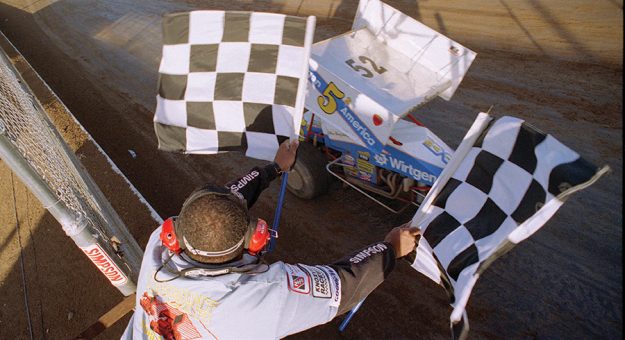“For two years after my accident, it was a pretty dark time,” Doty said. “You know right after my accident a lot of people came to the hospital and for the first two weeks, I was on morphine so I don‘t remember much about that. But when I was in rehab there were people who would stop by, but their life went on and racing went on.
“That was a real struggle for me,” Doty added. “It was like how dare they? How can life go on? How can these guys load up and travel the country and enjoy what they are doing when I can‘t do it anymore? I spent a lot of time feeling sorry for myself.”
Then out of the blue, he was asked to join the Slick 50 broadcast team? He had never done anything like this. His lack of television experience was not the initial source of his hesitation. He was more worried about practical matters.

“I hadn‘t flown since I was paralyzed and I hadn‘t rented a car or stayed in a hotel,” he said. “The logistics of getting there and staying there concerned me more than doing the television job. I was so naïve about the television part of it. I guess ignorance is bliss. I agreed to it and my dad flew out with me the first time. But I did it on my own after that.”
In fact, there were problems getting him to the booth. Doty had to be carried up and down through the grandstands to reach the booth. But behind the microphone, Doty quickly learned that being in the presence of professionals made all the difference.
“Mike Joy and Dick Berggren could not have been any better people to work with or to learn from,” he recalled. “Mike was so patient and calm in explaining things to me during commercial breaks. It was awesome.”
He learned about production meetings, chaos in the truck and dealing with voices in headsets. He was naturally timid at first, but when he started sharing using his trained eye to enhance the broadcasts, he found his groove.
With the bright lights of the camera trained on them, the drivers could engage in a bit of branding. People from across the sport were watching and it was a chance to truly get a glimpse into these men‘s souls.
Sheheen underscores how critical this moment was for so many.
“The Slick 50 Sprint Car World Series launched many careers,” he said. “It certainly poured a bunch of methanol on my career and it did the same for guys like Danny Lasoski. Danny began to make a name for himself for what he did on and off the track. He did those interviews with me and ended them with a wink. He figured it out. His nickname was perfect. The Dude. We all saw this as opportunities to grow. Danny knew what live television could do for him and he jumped on it.”
Sheheen and Doty emphasized that much of what made this time so special was what happened off the track.
“There was a restaurant named Bobby McGee‘s that was open on Sunday night,” Sheheen recalled. “And everyone would just bail out of the race track, and we were all hammer down headed there. And it was on.”
The stories and the wisecracking were the attraction and soon the fans caught on. The extracurricular activities became a part of the narrative shared with a nationwide audience.
“We were always looking for features to do with the intention of getting the helmets off of these guys.” Sheheen said. “How could we introduce the country to Keith Kauffman or Brent Kaeding who weren‘t as well known outside of their region? So one night we decided we were going to this paintball deal. I‘m hiding behind this rock with my paintball gun and I stand up to take a shot and I get drilled in the left side of my groin. Bam. So I‘m looking for who got the shot and Lasoski is pulling Guy Forbrook‘s wheelchair back as fast as he can and they are both giggling like a couple of schoolgirls.”
Then there were the infamous motorized bar stool races where Lasoski‘s mount caught on fire and Shaheen acquired a scar he has to this day.
“We put clips on the air and it really resonated with the race fans,” Sheheen said.” They thought these World of Outlaw guys were really something else. It was a great way for racers to connect with sponsors and fans. They took their brand to a new level. Racing and racers have always had a mystique and we had 10 weeks of things to share like this. The fans loved it and we had a new story every week.”
Three decades later participants who made this series happen know they were a part of something special.
“This was groundbreaking and I was thrilled to be a part of it,” Sheheen said. “There was no way it was going to fail. Ten weeks of this at the time of the year when nothing else was on, and it was live every week. We had Steve (Kinser), Sammy (Swindell), and (Dave) Blaney, and we were doing it in Arizona. It had all the things you needed to make this thing awesome. It was a dream job.”
